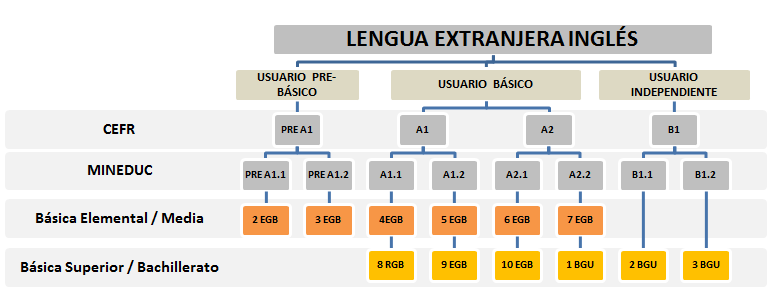Estándares de Inglés
Ecuadorian in-service
English Teacher Standards
The Ecuadorian in-Service English Teacher Standards are based on the document developed by the Teachers of English to Speakers of Other Languages (TESOL) as the organization’s K-12 ESL Teacher Standards (2009) which is widely used in countries such as Albania, Paraguay, and the United States.
This document is organized into five domains that fit with those stated for the general curriculum and of some which are related to English language teaching and learning.
The first domain, “Language” includes specific domains for language structure and communication, language acquisition and development and language fluency.
Given the fact that Ecuador is a multicultural country, a certain number of Ecuadorian students who are learning English may descend from indigenous cultures— where Spanish is their second language; and English their third— the second domain is about “Culture”. Therefore, Ecuadorian English teachers need to have knowledge of other cultures and know how culture may affect their learning of English in Ecuador.
The third domain is devoted to “Curriculum Development”, particularly aspects related to planning for standards-based English, implementing and managing standards, and using resources and technology effectively.
The fourth domain deals with “Assessment” (i.e. the gathering and evaluation of information related to English language learning) and includes the issues involved for learners as well as those related to language proficiency and classroom-based assessment.
Finally, the fifth domain embodies the matter regarding “Professionalism and Ethical commitment” to keep teachers current with new instructional techniques, research results, and advances in the English teaching field for professional development.
The English Language Learning Standards (ELLS) are outcomes students are expected to achieve at the end of a proficiency level in terms of knowledge and skills gained throughout the process. It means that they will show “what students must know and be able to do as they move toward full fluency in English1”.
The ELLS are based on the Common European Framework of Reference for Languages: Learning, teaching, assessment (CEFR) as they provide a common basis for the explicit description of objectives, content, and methods. The proficiency levels set by the CEFR and established as the benchmarks for Ecuador’s ELLS are A1, A2, and B1. The progression of the levels is the following
Educación General Básica (sublevel Elemental and Medio)
- Level PREA1: at the end of 3rd year
- Level A1: At the end of 5th year
- Level A2: at the end of 7th year
Educación General Básica (sublevel Superior and Bachillerato General Unificado)
- Level A1: At the end of 9th year
- Level A2: At the end of 1st year
- Level B1: At the end of 3rd year

The English Language Learning Standards are developed taking into consideration the communicative language components and the language skills as a core part of the program: (a) listening, (b) speaking, (c) reading, and (d) writing.
